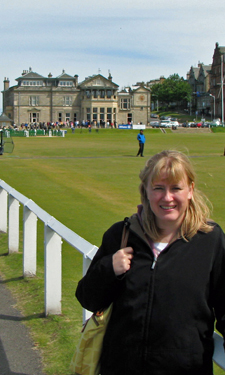 If you ever come visit us at NRPA headquarters in northern Virginia, you will notice that we are located next to quite a nice public golf course in Brambleton Regional Park. So golf is never far from mind. A few years ago, I began to see golf as a possible great family activity for our three older teenage boys. So, with some used clubs from eBay and the help of generously low greens fees for youth at our local city course, we embarked on a new family hobby, having fun together outside with nary a complaint of boredom.
If you ever come visit us at NRPA headquarters in northern Virginia, you will notice that we are located next to quite a nice public golf course in Brambleton Regional Park. So golf is never far from mind. A few years ago, I began to see golf as a possible great family activity for our three older teenage boys. So, with some used clubs from eBay and the help of generously low greens fees for youth at our local city course, we embarked on a new family hobby, having fun together outside with nary a complaint of boredom.
I’m not sure most people think of golf as a family activity, and I suspect this is part of the sport’s problems. The list of obstacles to participation is lengthy: strict traditions and rules, a difficult skill set, the high cost of equipment and greens fees, and a leisurely playing time. But these constraints can be overcome with a little imagination and clever restructuring of the game, as Arnie Biondo illustrates in this month’s Member to Member article.
It’s worth the effort, if you think about the game just in terms of NRPA’s three pillars. Golf courses preserve vast amounts of open space and often serve as part of community stormwater management and flood-control systems. Golf gets people out of their living rooms and offices to enjoy the trees and grass, all while getting a bit more walking and exercise than perhaps they realize. So while conservation and health and wellness are both strengths of the game, what about social equity?
It’s painfully obvious to everyone in the field: Golf needs to become more equitable in order to thrive. But golf has some hidden advantages that make it a great tool for equity. Handicaps and differently placed tee boxes allow players of different skills to play together, while special carts now enable people with disabilities to play. You don’t need to be particularly tall or fast or strong to play well, and players are playing against the course, not directly against each other, so there’s no aggressive offense or defense. These aspects not only make golf a good family activity, but potentially a great community sport. In our cover story, Sandra Gonzalez describes how the City of Pico Rivera in California not only saved its golf course, but turned it into a youth development opportunity that reaches hundreds of kids.
Parks and recreation is all about bringing the entire community together to recreate. People of different backgrounds and abilities learning to politely and respectfully play together on the golf course can only lead to greater acceptance and community spirit off course as well.

